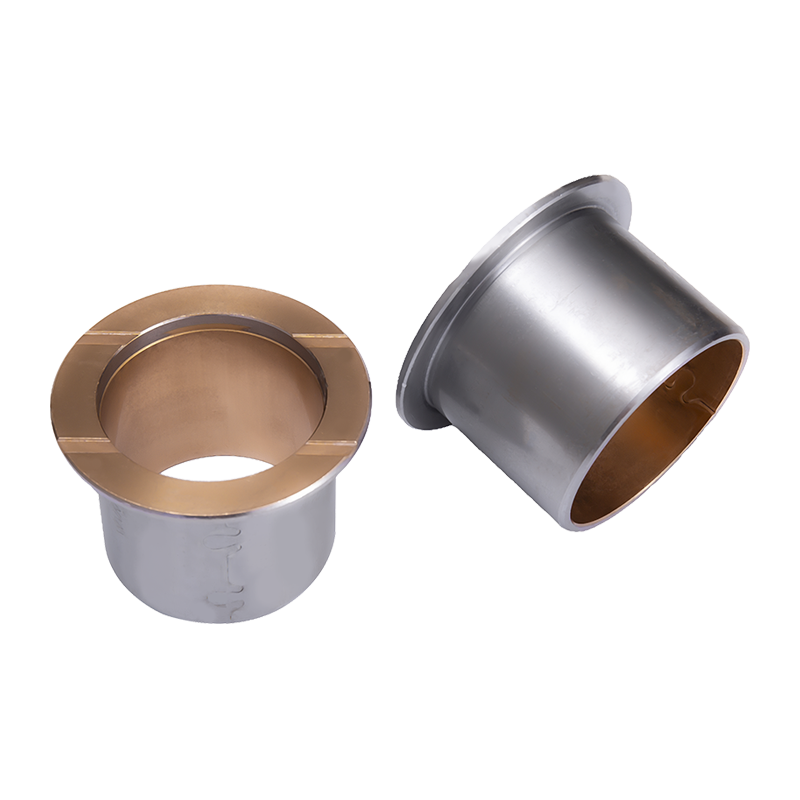Composite bushings are engineered plain bearings that combine multiple materials to achieve properties not possible with a single substance. Unlike traditional all-metal bushings, composite bushings are designed to provide low friction, high load capacity, and extended service life, often without the need for continuous lubrication. Their layered construction allows engineers to tailor performance for demanding applications in automotive, aerospace, industrial machinery, and renewable energy systems.
1. Typical Material Combinations in Composite Bushings
Composite bushings usually consist of a three-layer structure:
-
Metallic Backing (Steel, Stainless Steel, or Bronze)
The backing provides structural strength, dimensional stability, and load-bearing capacity. Steel is widely used for cost-effectiveness and rigidity, while stainless steel and bronze backings are chosen for corrosion resistance in marine, chemical, or outdoor environments. -
Porous Bronze or Sintered Metallic Layer
Bonded to the metallic backing, this porous layer acts as a transition zone. It provides mechanical anchoring for the sliding layer while enhancing thermal conductivity and load distribution. -
Polymer-Based Sliding Layer (PTFE, POM, or Thermoset Resin)
The top layer, often made of polytetrafluoroethylene (PTFE), polyoxymethylene (POM), or engineered thermoset resins, provides the low-friction and wear-resistant surface. This layer allows self-lubrication, reducing or eliminating the need for external grease or oil. Additives such as graphite, molybdenum disulfide (MoS₂), or fibers can be incorporated to further improve wear resistance and reduce friction under specific operating conditions.
2. Performance Enhancements Through Material Synergy
The layered design of composite bushings creates a balance of mechanical strength and tribological performance:
-
High Load Capacity
The metallic backing ensures that composite bushings can withstand significant loads while maintaining structural integrity, making them suitable for heavy-duty applications. -
Self-Lubricating Properties
The polymer-based sliding surface embedded with lubricants minimizes friction and wear, reducing the need for continuous lubrication and extending maintenance intervals. -
Corrosion and Chemical Resistance
When combined with stainless steel backing or corrosion-resistant polymers, composite bushings perform well in aggressive environments such as seawater exposure, chemical plants, or food processing equipment. -
Noise and Vibration Damping
The polymer surface layer reduces metal-to-metal contact, lowering noise levels and improving vibration damping in automotive and industrial machinery. -
Extended Service Life
The combination of high strength, low wear, and reduced lubrication requirements results in longer operating life, even under high-load or oscillating conditions.

3. Applications Leveraging Material Advantages
- Automotive: Suspension systems, steering components, pedals, and hinges benefit from self-lubricating properties and noise reduction.
- Aerospace: Lightweight, corrosion-resistant bushings reduce weight while withstanding high loads in control systems and landing gear.
- Industrial Machinery: Used in hydraulic cylinders, pumps, and conveyor systems where high wear resistance is needed.
- Renewable Energy: Wind turbines and solar tracking systems require maintenance-free operation with high load endurance.
Conclusion
Composite bushings derive their unique performance advantages from the combination of metallic strength and polymer-based tribological properties. By layering materials such as steel, bronze, and PTFE or POM, these bushings offer high load capacity, reduced friction, self-lubrication, corrosion resistance, and noise reduction. This synergy allows composite bushings to operate reliably across industries, especially in applications where maintenance-free performance and extended service life are essential.



 English
English русский
русский Español
Español عربى
عربى


